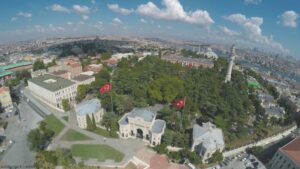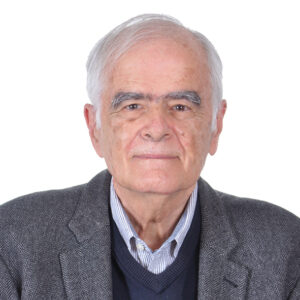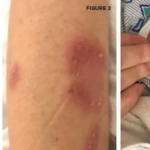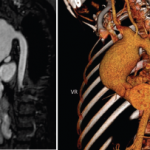 In 1937, the Turkish physician Hulusi Behçet described a number of patients with relapsing aphthous ulcers in the mouth and over the genitalia, as well as hypopyon iritis. Since that time, the eponymous condition, known as Behçet’s disease, has been recognized as a multisystem vasculitis that can present with myriad other signs and symptoms. Although the condition can be found across the globe, Turkey and other countries along the route once known as the Silk Road have been found to have a higher incidence of Behçet’s disease than in the rest of the world.
In 1937, the Turkish physician Hulusi Behçet described a number of patients with relapsing aphthous ulcers in the mouth and over the genitalia, as well as hypopyon iritis. Since that time, the eponymous condition, known as Behçet’s disease, has been recognized as a multisystem vasculitis that can present with myriad other signs and symptoms. Although the condition can be found across the globe, Turkey and other countries along the route once known as the Silk Road have been found to have a higher incidence of Behçet’s disease than in the rest of the world.
Through a confluence of circumstances, Hasan Yazici, MD, has enjoyed a professional life that has led him from Turkey to the U.S. and back again as he ascended to the rank of chair of the Behçet’s Disease Research Center and of the Division of Rheumatology at the University of Istanbul. Even more amazing, he has passed on his passion for the research and care of patients with Behçet’s disease to his son, Yusuf Yazici, MD, who is an associate professor of medicine and the director of the Behçet’s Syndrome Evaluation, Treatment, and Research Center at the New York University School of Medicine.
Early Years
After completing medical school at the University of Istanbul, Dr. Yazici traveled to Philadelphia to complete his intern year in internal medicine. He then moved to Nebraska, where he completed his internal medicine residency and rheumatology fellowship at Creighton University.

Dr. Yazici
Dr. Yazici recalls that a number of his professors assumed he had unique knowledge about Behçet’s disease because he had completed medical school in Turkey. However, he notes, in actuality, he didn’t know much more about the disease at that time than any other young medical trainee.
He intended to follow his medical residency with a fellowship in clinical pharmacology at the University of Iowa, but the guidance of a role model changed that plan.
Role Models
When Dr. Yazici was in his final rotation of his final year of medical residency, he met Paul D. Saville, MD, MRCP. At the time, Dr. Saville was the only academic rheumatologist in Omaha, seeing patients and teaching trainees while also overseeing the Metabolic Research Unit at Creighton. After only three weeks into his rotation, Dr. Yazici was convinced that he wanted to be a rheumatologist and, specifically, be a clinician-scientist like Dr. Saville.
“Apart from being a very caring physician and an expert on osteoporosis, Paul was also a master of organized skepticism,” Dr. Yazici notes.
Dr. Saville role-modeled the practice of questioning the conventional wisdom, and this had a big impact on Dr. Yazici.
“I was simply overjoyed when my first-ever dissenting letter to the editor appeared in Annals of Internal Medicine, followed shortly thereafter by another in The New England Journal of Medicine during my fellowship.”
Dr. Saville was also convinced that primary osteoarthritis was not a generalized disease, meaning that a patient could have Heberden’s or Bouchard’s nodes of the fingers even in the absence of osteoarthritis of the knees or hips. “He kept discussing with me how we could verify/falsify this hypothesis,” Dr. Yazici recalls. “With his guidance and encouragement, I prepared a protocol for a clinical study with a quite straightforward design. He sent me to his previous working place at the mecca of rheumatology, the Hospital for Special Surgery in New York City, and I was there for three months to conduct the study. A year-and-a-half later, the fruit of our labors appeared in JAMA, very much confirming his hypothesis.”
It was upon his return to Turkey that Dr. Yazici met another key role model in Asuman U. Muftuoglu, MD, whom he describes as the other clinician-scientist who was most influential in his academic career.
Dr. Muftuoglu had trained in Boston under the tutelage of William Dameshek, MD, arguably the preeminent American clinical hematologist of the time. Dr. Muftuoglu began to work at Cerrahpasa Hospital at the University of Istanbul, where Dr. Yazici had returned to work following his years in the U.S.
“It was with her guidance, clinical research expertise, scientific discipline, personal support and encouragement that I started the second academic rheumatology unit in Turkey and the dedicated, multidisciplinary Behçet syndrome outpatient clinic, the first of its kind,” says Dr. Yazici. “The weekly clinic, which had started in her office, is still very much active, with close to 15,000 registered patients.”
Honors
The awards and accolades that Dr. Yazici has garnered over the years are many and include the TUBITAK Science Award (the highest scientific award in Turkey). He served as president of the Turkish Society of Internal Medicine and the Turkish Society for Research and Education in Rheumatology. He received the Meritorious Service Award from the European Alliance of Associations for Rheumatology (EULAR), and was named a Master of the ACR.
Caregiver
Of importance to Dr. Yazici are the concepts he has learned about what makes for great clinical care. Dr. Yazici stresses the importance of always remembering that taking care of a patient is inseparable from caring for the patient.
Whenever possible, Dr. Yazici notes it is important to go back to the patient time and again to continue collecting a detailed clinical history.
It is also essential to remember the concept of pre-test probability and to apply Bayesian thinking, not only to the interpretation of tests but also to the interpretation of patient-reported symptoms and physical exam findings.
On the topic of diagnostic uncertainty, Dr. Yazici explains, “If you cannot come to a firm diagnosis at the end of a visit, reconcile with the obvious: There have always been more diseases around that have yet to be recognized and understood by the medical profession.”
For fellows in training and junior rheumatologists, Dr. Yazici shares the following words of wisdom:
- Even if you don’t plan to work in academic medicine, make a genuine attempt to be more knowledgeable and up to date in a limited area of rheumatology. You will be surprised to see this will also increase your overall medical acumen;
- Have respect for quantitative medicine;
- Cherish and allocate time to journal clubs to better your skills in organized skepticism. They are also a great deal of fun;
- Make sure that you do not sever your ties with internal medicine. Remember: You became an internist first;
- Remember that you will not be able to make a firm diagnosis in a substantial portion of your new patients. In the majority of the remaining patients, you will have a very good idea of what the patient has by the end of the history taking. Thus, treasure the time you allocate to history taking; and
- Be very much at ease when you tell your patient you do not know the diagnosis. [They] will more highly regard your professional opinion if you continue by telling [them] that you will read more about it and are seriously considering consulting with a colleague.
With a professional journey that demonstrates one never knows where a path in medicine may lead, Dr. Yazici urges others to follow their passions and seek to achieve the most they can in their careers while keeping their patients’ well-being and needs firmly in mind.
 Jason Liebowitz, MD, is an assistant professor of medicine in the Division of Rheumatology at Columbia University Vagelos College of Physicians and Surgeons, New York.
Jason Liebowitz, MD, is an assistant professor of medicine in the Division of Rheumatology at Columbia University Vagelos College of Physicians and Surgeons, New York.


